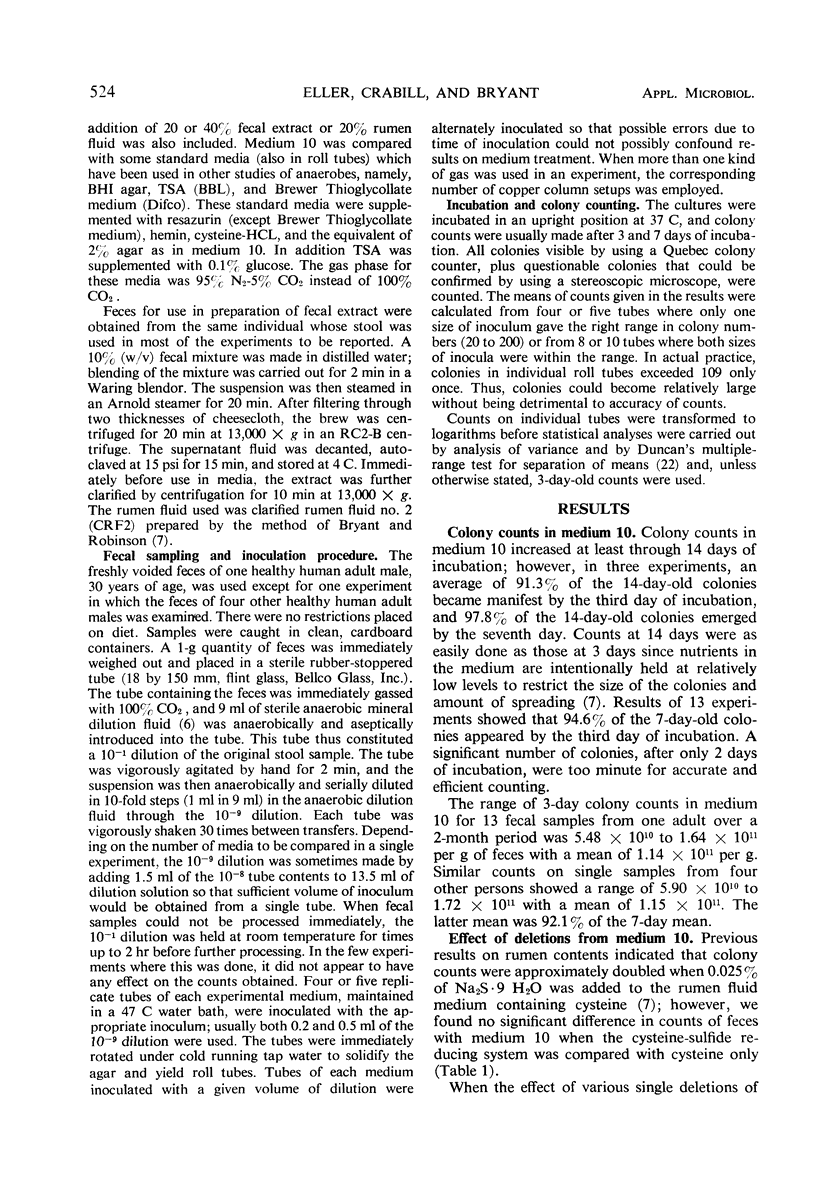Abstract
Medium 10 (M10), developed for rumen bacteria and containing small amounts of sugars, starch, volatile fatty acids, hemin, Trypticase, yeast extract, cysteine, and sulfide, plus agar, minerals and CO2-HCO3-buffer, was used with the Hungate anaerobic method as a basal medium to evaluate the efficacy of various ingredients. Three-day-old colony counts from adults on normal diets (17 samples) were 0.55 × 1011 to 1.7 × 1011 per g (mean, 1.15 × 1011) for M10. Single deletion of volatile fatty acids, Trypticase, yeast extract, or sulfide did not reduce counts. Deletion of hemin or both Trypticase and yeast extract significantly lowered counts. Addition of fecal extract, rumen fluid, 1% dehydrated Brain Heart Infusion (BHI) or 2 to 6% liver infusion did not increase counts; 1% dehydrated bile or 3.7% BHI markedly depressed them. Decreasing the gas-phase CO2 concentration from 100 to 5% with N2 and correspondingly lowering the HCO3 had little effect. Counts in supplemented Brewer Thioglycollate (Difco), BHI, and Trypticase soy agar were similar or lower than in M10; ease in counting was best in M10. Comparison of features of 88 predominant strains of fecal bacteria randomly isolated indicated that M10 supported growth of as many or more species of bacteria as compared to supplemented BHI. The results suggest that predominant bacteria of human feces, in general, are not as nutritionally fastidious as rumen bacteria and indicate that media for counts or isolation containing large amounts of rich organic materials are neither necessary nor desirable when adequate anaerobic techniques are used.
Full text
PDF







Selected References
These references are in PubMed. This may not be the complete list of references from this article.
- Arank A., Syed S. A., Kenney E. B., Freter R. Isolation of anaerobic bacteria from human gingiva and mouse cecum by means of a simplified glove box procedure. Appl Microbiol. 1969 Apr;17(4):568–576. doi: 10.1128/am.17.4.568-576.1969. [DOI] [PMC free article] [PubMed] [Google Scholar]
- Barnes E. M., Burton G. C. The effect of hibernation on the caecal flora of the thirteen-lined ground squirrel (Citellus tridecemlineatus). J Appl Bacteriol. 1970 Sep;33(3):505–514. doi: 10.1111/j.1365-2672.1970.tb02227.x. [DOI] [PubMed] [Google Scholar]
- Bryant M. P. Normal flora--rumen bacteria. Am J Clin Nutr. 1970 Nov;23(11):1440–1450. doi: 10.1093/ajcn/23.11.1440. [DOI] [PubMed] [Google Scholar]
- Bryant M. P., Robinson I. M. Effects of diet, time after feeding, and position sampled on numbers of viable bacteria in the bovine rumen. J Dairy Sci. 1968 Dec;51(12):1950–1955. doi: 10.3168/jds.S0022-0302(68)87320-5. [DOI] [PubMed] [Google Scholar]
- Caldwell D. R., Bryant M. P. Medium without rumen fluid for nonselective enumeration and isolation of rumen bacteria. Appl Microbiol. 1966 Sep;14(5):794–801. doi: 10.1128/am.14.5.794-801.1966. [DOI] [PMC free article] [PubMed] [Google Scholar]
- Drasar B. S. Cultivation of anaerobic intestinal bacteria. J Pathol Bacteriol. 1967 Oct;94(2):417–427. doi: 10.1002/path.1700940223. [DOI] [PubMed] [Google Scholar]
- Finegold S. M. Intestinal bacteria. The role they play in normal physiology, pathologic physiology, and infection. Calif Med. 1969 Jun;110(6):455–459. [PMC free article] [PubMed] [Google Scholar]
- Gibbons R. J., Kapsimalis B. Estimates of the overall rate of growth of the intestinal microflora of hamsters, guinea pigs, and mice. J Bacteriol. 1967 Jan;93(1):510–512. doi: 10.1128/jb.93.1.510-512.1967. [DOI] [PMC free article] [PubMed] [Google Scholar]
- HUNGATE R. E. The anaerobic mesophilic cellulolytic bacteria. Bacteriol Rev. 1950 Mar;14(1):1–49. doi: 10.1128/br.14.1.1-49.1950. [DOI] [PMC free article] [PubMed] [Google Scholar]
- Mah R. A., Sussman C. Microbiology of anaerobic sludge fermentation. I. Enumeration of the nonmethanogenic anaerobic bacteria. Appl Microbiol. 1968 Feb;16(2):358–361. doi: 10.1128/am.16.2.358-361.1968. [DOI] [PMC free article] [PubMed] [Google Scholar]
- Mitsuoka T., Morishita Y., Terada A., Yamamoto S. A simple method ("plate-in-bottle method") for the cultivation of fastidious anaerobes. Jpn J Microbiol. 1969 Dec;13(4):383–385. doi: 10.1111/j.1348-0421.1969.tb00482.x. [DOI] [PubMed] [Google Scholar]
- Moore W. E., Cato E. P., Holdeman L. V. Anaerobic bacteria of the gastrointestinal flora and their occurrence in clinical infections. J Infect Dis. 1969 Jun;119(6):641–649. doi: 10.1093/infdis/119.6.641. [DOI] [PubMed] [Google Scholar]
- Nottingham P. M., Hungate R. E. Isolation of methanogenic bacteria from feces of man. J Bacteriol. 1968 Dec;96(6):2178–2179. doi: 10.1128/jb.96.6.2178-2179.1968. [DOI] [PMC free article] [PubMed] [Google Scholar]
- Spears R. W., Freter R. Improved isolation of anaerobic bacteria from the mouse cecum by maintaining continuous strict anaerobiosis. Proc Soc Exp Biol Med. 1967 Mar;124(3):903–909. doi: 10.3181/00379727-124-31882. [DOI] [PubMed] [Google Scholar]
- Van Houte J., Gibbons R. J. Studies of the cultivable flora of normal human feces. Antonie Van Leeuwenhoek. 1966;32(2):212–222. doi: 10.1007/BF02097463. [DOI] [PubMed] [Google Scholar]
- Zubrzycki L., Spaulding E. H. STUDIES ON THE STABILITY OF THE NORMAL HUMAN FECAL FLORA. J Bacteriol. 1962 May;83(5):968–974. doi: 10.1128/jb.83.5.968-974.1962. [DOI] [PMC free article] [PubMed] [Google Scholar]


